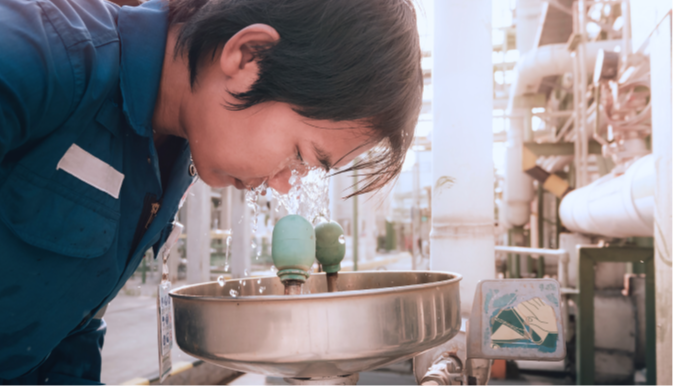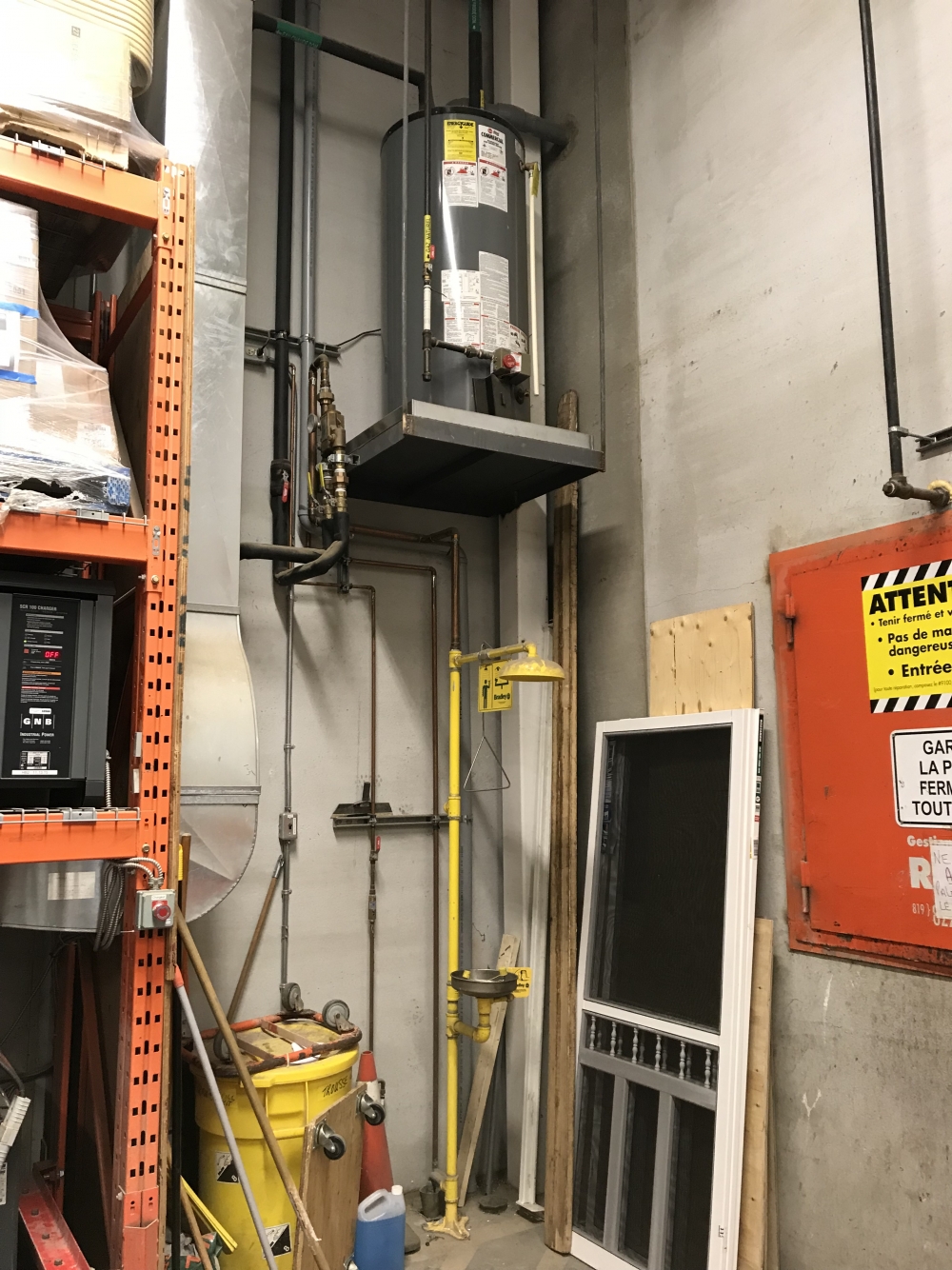
The presence of products or a dusty environment requires the presence of an emergency shower (1). However, it is essential that its installation complies with the current standard. But what is the Canadian standard?
It will also be necessary for this shower to function properly and to be subject to periodic maintenance.
Unfortunately, a recent study of 300 North American companies with more than 5,000 functional emergency showers in their buildings indicates that 88% of current facilities are non-compliant (3). It is indeed surprising that the emergency shower is largely ignored and that prevention programs are often incomplete. Is it because of negligence, lack of budget, time or resources or simply ignorance?
The emergency shower, whether deluge or eyewash, is a mandatory equipment when the working environment presents risks to the health of its workers. It not only provides an effective means of reducing the dangerous effects following an incident, but also gives the first responder time to get to the scene and provide first aid until arriving to the hospital.
When it comes to designing and installing an emergency shower, the Canadian reference is the American standard ANSI Z-358.1, version 2014 (2). While this standard is complete, many of its elements are often unknown if not ignored during an installation. However, more than thirty specific technical parameters and installations are described there.
Most people believe that the most important thing after an accident is to have access to water to thoroughly rinse the parts of the body affected by a toxic or corrosive product. However, it is also important to use clean or sterile water at the right temperature, at the right pressure so as not to damage the eyes or the affected tissues, in the right quantity and for a sufficient duration, at least 15 to 20 minutes and even more depending on the severity of the situation or the product to be rinsed off.
All drench-type showers must be connected to the drinking water network, as they require a higher water flow depending on the type of equipment and the size of the connection. However, in recent years, eyewash showers with integrated and autonomous tank have appeared on the market and they do not require any connection to the water network, because their flow is much lower. Several models of stand-alone showers are available and arecompliant to the requirements of standard Z-358.1 (2). Their installation and maintenance are simplified and more flexible while allowing substantial savings.
While each of these operating parameters is important for the efficiency and comfort of an emergency shower, there are other important parameters to consider.
Installation parameters are just as important as operating parameters to allow each shower to perform its functions properly when it is activated in an emergency.
Following an accident, the employee must get to the shower in less than 10 seconds to minimize the risk to his health. The standard states that the shower must be accessible and cannot be more than 17 m (55 ft.) from the chemical handling site. The journey must be made in a straight line, without any obstacles such as a door, a step or equipment.
The standard states that the shower must be identifiable by means of signs, preferably universal pictograms, so that it is recognized by all and visible from afar (2). The employee must then be able to easily activate the shower either by a controller, a lever or a handle.
Even if the shower is well installed and functional, all jets must be adjusted so that the water is directed directly and gently to the affected parts of the body. It often happens that the jets of water from an eyewash station do not do their job properly, because they do not irrigate both eyes equally.
Like any equipment used for health and safety, each eyewash and drench shower must be checked and tested periodically, as it must perform its work instantly when in use. It should also be activated weekly to prevent the accumulation of stagnant water in the water pipe. Activation also validates the cleanliness of the unit, the adequate temperature of the water and the ease of activation of the shower to name a few parameters.
The annual maintenance is more complete and makes it possible to validate, among other things, the accuracy of the water jets, the water flow per minute as well as the replacement of worn or defective components.
Although the Z358.1 standard is accurate, some studies conclude that 88% of the emergency showers inspected are non-compliant and could even compromise the health of employees who would need to use them (3).
One of the most common problems is the improper installation of a drench-type shower that requires a significant amount of water but is connected to a pipe that is too small. When this shower is activated, it must be remembered that after 15 minutes, there may be between 300 and 400 gallons of water to be evacuated through a drain. The question now is whether there is a floor drain and whether it has the size required to evacuate all this water.
Improper installation and defects in components are also causes of non-compliance. Even if several models of showers are offered by manufacturers, it is disappointing to note that they do not all meet the standard. This only adds to the confusion among business managers who must make decisions that are important to the health and safety of their employees. The periodic inspection program will then allow repairs to be made to the defective components.
Water quality is one of the least measured parameters during an inspection. Quality is defined by having drinking water in the right quantity, at the right temperature, for a period of time that meets the needs.
The emergency shower must be always accessible in case of need. It is necessary to delimit a very precise and visible space around the shower that will serve no purpose other than use in case of emergency. It will therefore be forbidden, at all times, to store equipment within this perimeter.
Emergency showers are required by occupational health and safety organizations and by good business practices. The engineer designs the shower, the OHS manager develops best practices according to the risks present and the maintenance employee takes care of the proper functioning of the equipment. The users of the shower therefore trust a whole team that takes care of their health and well-being.
However, does the employee have all the information required to activate and properly use the emergency shower? Yet he is the one who will use the shower in case of emergency. How well does he know the effects of the chemicals he handles every day? Does an employee who is splashed by a chemical know that she must completely undress in front of her colleagues to limit the burning of the product that has soaked her underwear? Knowingly, she might request to have a shower curtain in place which is an option often overlooked during the initial installation.
Emergency showers are installed for users, and they must be consulted during an installation. This equipment is put in place for their safety and even if the periodic maintenance is not under their responsibility, knowingly, they will be able to demand the maximum safety for their health.
According to Article 75 of the Regulation on Occupational Health and Safety (OHS), the installation of body showers and eyewash stations is required when a worker handles:
According to Article 76: In addition, these must be located within the immediate reach of exposed workers and be supplied with lukewarm water.

Although the installation of an emergency shower seems simple at first glance, it is important to communicate with experts who understand the requirements of the Z358.1 standard (2). As an expert, the designer can choose the right shower that will meet the risks and he will make sure to comply with all the technical and installation parameters. The proposed shower must be accessible at all times, and it must instantly offer, on request, an adequate quantity of water, at the right temperature, for a sufficient period of time and thus allow first responders to provide first aid while going to the hospital.
Following the installation of the shower, the employee health and safety officer will have the duty to train users and implement a periodic maintenance program that will ensure the proper functioning of the equipment. In conclusion, properly installed and well maintained according to the standard, the shower will faithfully fulfill its role as emergency equipment for the benefit of the employees.
We use cookies to understand how you use our site and to improve your experience. This includes personalizing content and advertising. By continuing to use our site, you accept our use of cookies, terms and conditions, privacy policy. Confused? Send us an e-mail.
I acceptWe use cookies
Respecting your privacy matters to us. We use cookies to personalize our content and facilitate your digital experience. Some cookies may be collected with your consent.
Essential
Essential cookies help make a website usable by enabling basic functions such as page navigation and access to secure areas of the website. The website cannot function properly without these cookies.
Performance
These cookies enable us to analyze navigation on our sites and improve their operation.
Customization
Preference cookies enable a website to remember information that modifies the behavior or appearance of the site, such as your preferred language or the region you are in.
Targeted advertising
These cookies help us limit the number of times you see an advertisement, personalize our offers and services according to your centers of interest, measure the effectiveness of an advertising campaign, and so on. They may be shared with our partners.
We use cookies
Respecting your privacy matters to us. We use cookies to personalize our content and facilitate your digital experience. Some cookies may be collected with your consent.